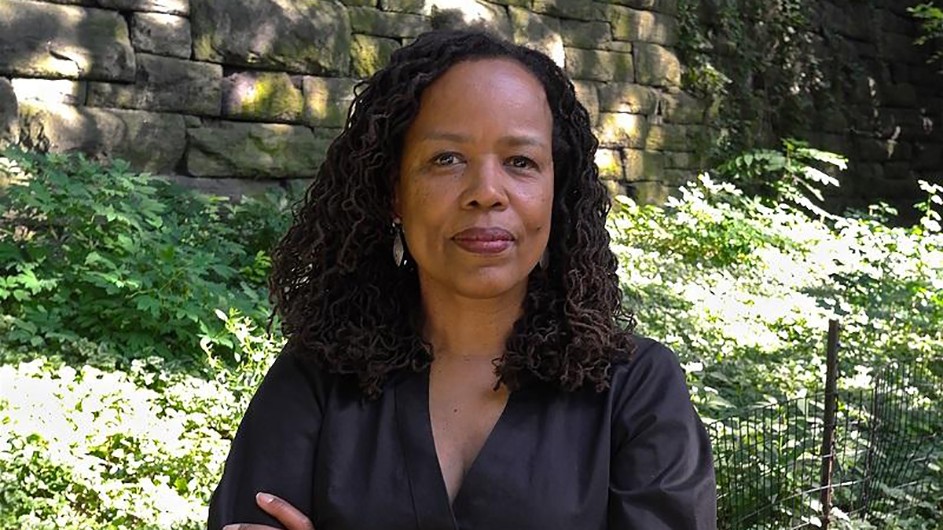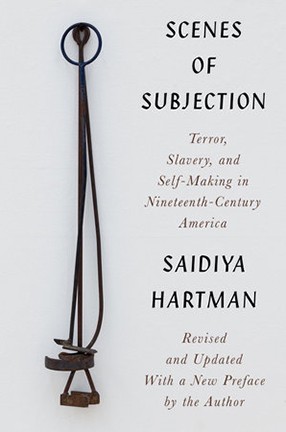A New Edition of Saidiya Hartman’s First Book Has Just Been Published
Scenes of Subjection: Terror, Slavery, and Self-Making in Nineteenth-Century America is now revised and expanded, 25 years later.

In 1997, University Professor Saidiya Hartman published her first book, Scenes of Subjection: Terror, Slavery, and Self-Making in Nineteenth-Century America, in which she explored racial subjugation during slavery and its aftermath. She examined the forms of terror and resistance that shaped Black identity, including forms of domination that usually go undetected, by looking at sources from the margins of the historical archive—slave narratives, plantation diaries, popular theater, slave performances, freedmen’s primers, and legal cases.
A 25th-anniversary edition of the book, revised and expanded, has just been published, so that a new generation of readers can discover how Hartman investigates the forms of routine terror and violence characteristic of slavery, that intertwining of injury, subjugation, and selfhood seen even in abolitionist depictions of enslavement.
Hartman discusses the new edition with Columbia News, along with her thoughts on how the discourse about race has changed in this country, and the class she is co-teaching this semester.
What was the impetus for a 25th anniversary edition of this book?
The initial impetus was rather prosaic. I wanted to correct the errors in the first edition. However, once I re-entered the book, the plan for revision expanded. I decided to invite others to collaborate and contribute to the text. There is a forward by Keeanga Yamahtta-Taylor, an afterword by Marisa Fuentes and Columbia History Professor Sarah Haley, compositions by artist Torkwase Dyson, and notations with Cameron Rowland. As a result, the anniversary issue does feel like a new book.

How do you think the conversation about race has changed in America over the past quarter-century, since you published the first edition of this book?
The conversation about race has changed dramatically. When I began the book, scholars and intellectuals were struggling to develop critical theories of racial subjection, domination, marginalization, and social precarity. As well, the prevailing discourse on slavery often referred to chattel slavery or racial slavery as “African American slavery,” as if it were a particular aspect of minority experience, or confined to Black history rather than an institution and practice that transformed Europe, Africa, and the Americas, and substantially impacted Asia. Also, racial slavery fueled capitalist modernity.
Today, there are robust and varied theories and conceptual approaches to race and racialization that have transformed our understanding of matters ranging from the Enlightenment to the history of capitalism.
Advice for anyone interested in pursuing a career in academia?
Anyone passionate or reckless enough to pursue a career in the humanities in the current era of austerity and downsizing, anyone willing to devote themselves to a vocation in which employment is uncertain, is already following their passion. Scholarship is a labor of love.
What are you teaching this semester?
I am teaching a graduate seminar, Radical Composition, with Professor Deborah Paredez in the School of the Arts. The course examines literary experiments in prose and poetics by 20th century and contemporary writers. The texts have included works by Svetlana Alexievich, Anne Carson, M. NourbeSe Philip, Ross Gay, Anne Boyer, Tyehimba Jess, Theresa Hak Kyung Cha, Nathalie Léger, Sven Lindqvist, Audre Lorde, and others. The authors are involved in radical experiments in narrative, documentary poetics, visual graphics, textual assemblage, archival fabulation, poetic form, nonfiction monologue, and auto-theory. Topics range from assembling an archive of the undocumented to histories of colonial war and bombing, from auto-fiction to fourth-person narration.
The students in the seminar are wonderful. They are from journalism and narrative medicine, art history and comparative literature, African American studies and architecture, and creative writing students in nonfiction, poetry, and playwriting. I have learned so much during the semester.
What is the best part of teaching at Columbia?
Great students and brilliant colleagues. I am an interdisciplinary scholar, so I love teaching students from all parts of the campus. The intellectual and cultural resources of New York City greatly enrich the classroom. In my courses, students often meet the writers and intellectuals we are reading. In the spring, I will teach a micro-seminar on Black Poiesis, and each writer we study will visit the seminar and give a public talk.